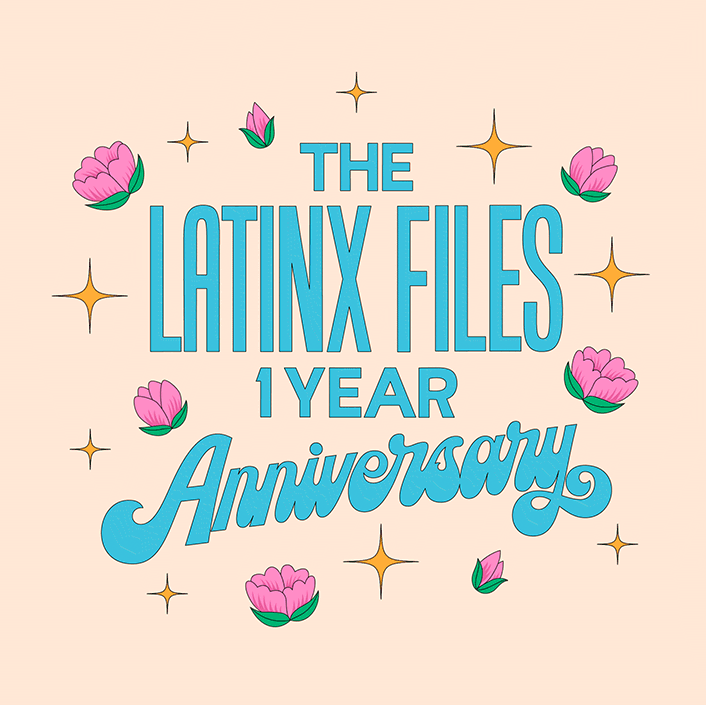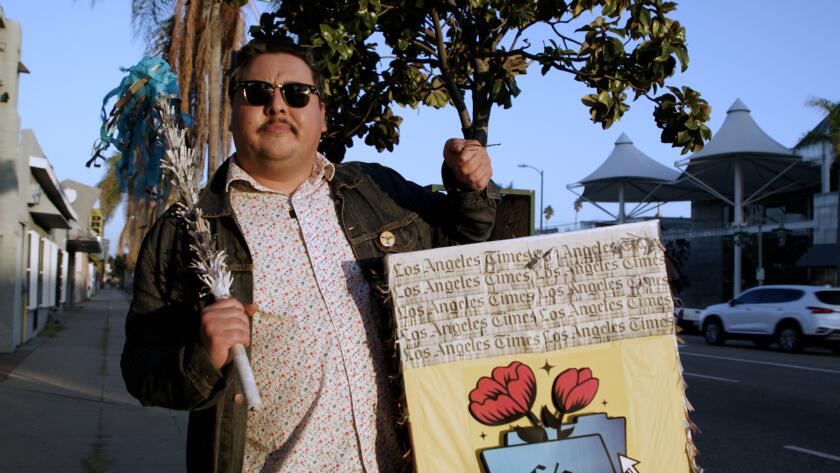Latinx Files: The ‘skin color’ question that set off fireworks; also, it’s our cumple

This Friday will be exactly one year since we launched the Latinx Files.
A whole year under the belt for this “little blog,” as my therapist calls it. Can you believe it? I certainly can’t. If this moment were a meme, it’d be Paul Rudd saying “Hey, look at us!”
And I do mean us. This newsletter, this paper for that matter, would be nothing without you, the reader. Before we kick off the 53rd edition of this weekly newsletter, I wanted to take a moment to say something with my whole chest.
Thank you. From the bottom of my heart.

The Latinx experience chronicled
Get the Latinx Files newsletter for stories that capture the multitudes within our communities.
You may occasionally receive promotional content from the Los Angeles Times.
Thank you for making this newsletter part of your Thursdays. Thank you for allowing and entrusting me to share your stories and memories — whether they be about your Noche Buenas or loved ones you lost to COVID-19. Thank you for letting me open up about my struggles with anxiety and depression. There are no other words or feelings that better capture what I’m experiencing right now other than gratitude.
I wanted to do something special for our birthday, so I got a piñata. We even made a video.
A special thanks to my friend Charlie Vela, who gave me the idea to get a piñata. He made a short documentary called “Piñata People,” which you should watch. A shoutout also to Lorena Robletto of Amazing Piñatas for making it. Her work is currently featured at the Craft in America Center’s “Piñatas: The High Art of Celebration” exhibit, which runs until Dec. 4.
And now, without further ado, here’s this week’s newsletter.
On that recent Pew study that went viral
In January 2022, the University of Texas Press will publish “The Mexican American Experience in Texas.” Written by UT anthropology professor Martha Menchaca, the book is a historical account of Mexican Americans in the region. Menchaca begins with an explanation of New Spain’s Sistema de Castas, a legal system that established a racial hierarchy and granted power and control to peninsulares — Spanish people who came from Spain — and criollos, their American-born descendants.
These rigid rules were relaxed somewhat when it came to colonizing the northern frontier. The Spanish crown had a hard time recruiting people to establish colonies in the territory — the Native people of those lands were defending themselves against invaders, after all — so it incentivized racially mixed people to move there with land grants.
Our daily news podcast
If you’re a fan of this newsletter, you’ll love our daily podcast “The Times,” hosted every weekday by columnist Gustavo Arellano, along with reporters from across our newsroom. Go beyond the headlines. Download and listen on our App, subscribe on Apple Podcasts and follow on Spotify.
As time went on, these land grants became a way for the racially mixed colonizers to claim whiteness and the privileges that came with it. According to census data from the period, the number of people of color went down while the Spanish population increased. In fact, if this data were to be believed, Texas had a higher percentage of Spanish people than the rest of New Spain. (I sometimes think of the poetic irony of these people working so hard to claim Spanish whiteness only to have it trumped by the Anglo-Saxon whiteness that eventually fueled Texas’ independence.)
I was reminded of Menchaca’s book this week after the Pew Research Center published a report that went viral because of this tweet:
People had takes. I had one. The reaction was visceral, with many questioning why Pew would even conduct this survey in the first place. The use of emojis certainly didn’t help. Such was the backlash that Pew responded to the initial tweet with a thread adding context, pointing out that it wasn’t them saying this was the racial breakdown of Latinxs in the United States, but rather the responses they got from people who were asked to self-identify their skin color. The question was part of a larger survey that asked about skin color and discrimination — the title of the report is “Majority of Latinos Say Skin Color Impacts Opportunity in America and Shapes Daily Life.”
“In this study, we wanted to understand if and how Hispanics in the U.S. are experiencing discrimination based on skin color, also known as colorism,” said the nonpartisan think tank.
It turns out yes.
According to the report, 62% of respondents said having darker skin color hurts Latinxs’ ability to get ahead; 59% also said that having lighter skin helps Latinxs’ ability to get ahead. When asked if skin color shaped their daily life experiences, 57% said yes.
It makes some sense, then, why people who have acknowledged that colorism and racism exist would choose a lighter skin color when asked how they see themselves.
I’m not saying it’s right. I know it couldn’t be me, though. At best, it’s aspirational and, at worst, delusional.
Whether we’d like to admit it or not, colorism is very much a part of Latinx culture. How could it not? It was brought over by the Spanish, along with their language, religion and diseases.
Some encourage it — how many of you grew up with a family member who used the term “mejorar la raza”? — while others clown it. In Mexican culture, the insult “tienes el nopal en la frente,” a reference to the cactus in the country’s flag, is lobbed at anyone who may be perceived as acting “too white.”
Back in February, I was asked to moderate a conversation with journalist Paola Ramos in promotion of her book “Finding Latinx: In Search of the Voices Redefining Latino Identity.” During the Q&A section (you can watch it here, it starts at around the 52:20 mark), an audience member asked us both if we believed Latinxs would be “subsumed into whiteness” the way that Italian and Irish Americans had. I said no because I believed that there were too many Latinxs in this country and our families’ countries of origin were so geographically close that those ties bound to the diaspora would not disappear. That proximity also likely means that new immigrants will continue coming here.
But I also said that some Latinxs would want to be absorbed into whiteness. The people of color who colonized Texas did then, and this Pew study suggests that it’s at least partially going on now.
Consider subscribing to the Los Angeles Times
Your support helps us deliver the news that matters most. Become a subscriber.
Meet our Latinx staff: Angel Rodriguez
The Los Angeles Times employs more than 60 Latinx journalists. One of the goals of this newsletter is for you to meet them all. This week, we highlight Angel Rodriguez, special projects editor. He also edits this newsletter. He’s that tío that always has your back. None of this would have been possible without him.
“You’re essentially other people’s collective efforts.”
That line by one of our readers, Joshua Rivera, has stuck with me since I read it. I know how accurate it is for me and so many others like me.
My parents came to this country in the Cuban “freedom flights” of the late ’60s and ended up in Chicago. How they ended up in a cold Midwestern city as opposed to Miami was pretty simple. They had friends who could get them jobs in the factory they worked at. The fact that they knew only a handful of people, had never experienced or much less seen snow in their lives and didn’t understand the language or the culture was dwarfed by their need to put food on the table.
After a decade of getting by and seeing the friends they’d made in Chicago move away, they relocated to Houston. Why Houston? They had friends who could get them a job at their place of employment.
I was lucky enough to graduate from a state school thanks to my parents’ collective effort.
I didn’t realize how much they had sacrificed until I overheard my dad once telling my mom that, now that I had graduated, she could finally afford to buy an ice cream at work. It really hit me at that moment, and it made me feel horrible for the number of times I’d called them for a little extra money to pay for whatever dumb thing I thought I needed at that time.
My journalism career has taken me to all parts of this country, has allowed me to work in some of the largest newsrooms in the world and has given me the ability to experience things that my parents never had the opportunity to do.
Those saved ice cream cones gave me a career I am very proud of. Not because of any achievements or personal gain but because I have been able to, in a tiny way, pay back my parents for their collective efforts.
But I can honestly say the most gratifying part of my career has been the ability to work on this newsletter and with some of the brightest Latino journalists in the country. The daily chats with Fidel about what you read every week has reconnected me to cultural touch points that I had let slide over the years. The illustrations directed by our designer Martina Ibañez-Baldor have made me smile and think. The stories told by our readers and staff have made me cry more often than I’d care to admit.
And as we reach the year anniversary of the launch of the newsletter, it is worthwhile to also look ahead — to go from “imaginando cosas chingonas” to “haciendo cosas chingonas.” Keep an eye out for some cool new things for Year 2 of this newsletter. As my dad always said, “Pa’ tras ni para coger impulso.”
Stories we read this week that we think you should read
— Eight people died Friday after the crowd at the Astroworld music festival in Houston stampeded toward the front of the stage to watch headliner Travis Scott perform. At least four of the victims were Latinxs. Their names are Brianna Rodriguez, 16; Rodolfo Angel Peña, 23; Franco Patino, 21; and Axel Acosta, 21. On Monday, CNN reporter Ed Lavandera posted a video that captured the grief over this tragic loss of life. It shows Acosta’s family holding photos of him as mariachis play the song “Mas alla del sol.”
You can read more of our Astroworld Festival coverage here. I also encourage you to read the Houston Chronicle’s reporting.
— Los Angeles County Sheriff Alex Villanueva recently called Times columnist Gustavo Arellano a “vendido” in a weekly Facebook Live presser. In response, Gustavo pulls out the receipts and asks who’s the real vendido.
— Speaking of the Los Angeles County Sheriff’s Department, a recent Times analysis found that the agency had used minor stops to search bicyclists, with Latinxs hit the hardest. From the report:
The Times’ analysis of more than 44,000 bike stops logged by the Sheriff’s Department since 2017 found that 7 of every 10 stops involve Latino cyclists, and bike riders in poorer communities with large nonwhite populations are stopped and searched far more often than those in more affluent, whiter parts of the county.
— After 20 months of being closed to nonessential travel, the U.S-Mexico border has reopened. Families were reunited, tears were shed, and at least one Mexican national satiated his Whataburger craving. For more, my San Diego Union-Tribune colleagues Wendy Fry, Alexandra Mendoza and Kate Morrissey have you covered.
— The latest edition of Image, The Times’ style magazine, is out. The theme? Sportsball, baby! Highlights include this photo essay on pickup soccer by Las Fotos Project, a Q&A with Doyer legend Jaime Jarrín, and a love letter to the Dodgers hat, which has become the universal symbol of L.A. love.
— Shockingly relevant 50 years after it aired in 1971, a Chicano TV series is digitized after its host rescued it from a box in his Orange County garage. Times staff writer Dorany Pineda has the story.
— Ricardo Romo, author of the book “East Los Angeles: History of a Barrio,” has a Substack. This week, he wrote about San Antonio chef Johnny Hernandez. You can sign up for Romo’s “Latinos in America” newsletter here. (h/t Gustavo Arellano).
— The best thing on the Latinternet this week: The Pittsburgh Steelers defeated the Chicago Bears on Monday night. During the postgame interview, ESPN Deportes reporter John Sutcliffe asked Steelers running back Najee Harris (a key cog in my L.A. Times fantasy football team) if he was familiar with “La Cucaracha.” An enthusiastic Harris interjected and began singing Grupo Control’s banger “Tao, Tao.” Check out the viral clip.
And now for something a little different...

Patricia Hernandez is a Latinx Indigenous diaspora artist. She is the creator and owner of PATL.SV, based in Atlanta. Hernandez is a cultural organizer and self-taught artist. She portrays her Latinx culture, Indigenous ancestry and immigrant experience through colorful, vibrant paintings, murals in a small and large scale, and illustrations.
“For this piece I wanted to raise awareness of the immigrant labor done by Indigenous, Latinx and minority Americans who work in the farms. Thanks to them we have food on our tables. This month is Native American Heritage Month and we give thanks for all the challenges in life that makes us thrive and make our voices become louder. As a daughter of farmers, this is a valuable job that nurtures the whole land and environment. The harvest that feeds our homes, children and families. Especially this coming holiday season.”
Are you a Latinx artist? We want your help telling our stories. Send us your pitches for illustrations, comics, GIFs and more! Email our art director at martina.ibanezbaldor@latimes.com.
The Latinx experience chronicled
Get the Latinx Files newsletter for stories that capture the multitudes within our communities.
You may occasionally receive promotional content from the Los Angeles Times.





